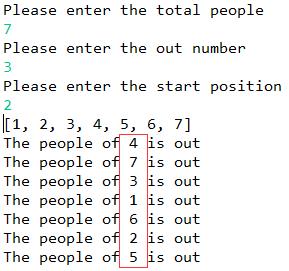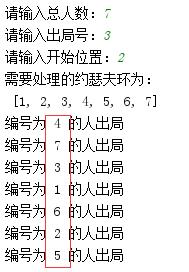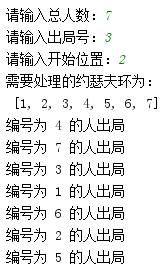趣味算法--约瑟夫环问题
Posted 鸡蛋番茄
tags:
篇首语:本文由小常识网(cha138.com)小编为大家整理,主要介绍了趣味算法--约瑟夫环问题相关的知识,希望对你有一定的参考价值。
问题描述
已知n个人(以编号1,2,3,...,n分别表示)围坐在一张圆桌上。指定编号为k的人开始从1报数,数到m的那个人出列;出列那个人的下一位又从1开始报数,数到m的那个人出列;以此规则重复下去,直到圆桌上的人全部出列。
分析解决
解决方法主要有逻辑分析、数学分析法。
逻辑分析:就是按照游戏规则一个个报数,报到m的人出局,结构层次简单清晰明了。这种方式实现主要采用顺序表实现
数学分析:采用数学方式归纳统计分析出每次出局人的规律,直接得出每次出局的人,然后以代码实现。这种方法需要较强的数学分析能力,代码较简单。这种实现主要采用数学公式。
逻辑分析
先以C语言数组为例,由于C语言数组不能像Java、Python这种面向对象语言的数组那样使用删除数组元素的方法,每次删除数组中的一个元素,都要将后面元素前移一位,这里简单的将删除的元素值设为0。
假设总人数n=7,从编号k=2的人开始,数到m=3的人出局,下面是分析过程。


1 #include <stdio.h> 2 3 int main(void) 4 { 5 int total; //define total people 6 int out; //define out number 7 int start; //define start number 8 9 /* set the total, out and start number */ 10 printf("Please enter the total people\\n"); 11 scanf("%d", &total); 12 printf("Please enter the out number\\n"); 13 scanf("%d", &out); 14 printf("Please enter the start position\\n"); 15 scanf("%d", &start); 16 17 int people[total]; //init the people 18 int i = start - 1; //init i for people tag 19 int count = 0; //init count for the people out 20 int remain = total; //init the remain number of people 21 22 /* init josephus ring */ 23 int j = 0; 24 for (j = 0; j < total; j++) 25 people[j] = j + 1; 26 27 /* begin to solve josephus problem */ 28 printf("begin to solve josephus\'s problem.\\n"); 29 /* print josephus ring */ 30 for (j = 0; j < total; j++) 31 printf("%d ", people[j]); 32 printf("\\n"); 33 34 while (1) 35 { 36 if(people[i] > 0) 37 { 38 count++; 39 }else 40 { 41 i++; 42 if (i == total) 43 i = 0; 44 continue; 45 } 46 47 if(count == out) 48 { 49 printf("The people of %d is out.\\n", people[i]); 50 people[i] = 0; 51 count = 0; 52 remain--; 53 } 54 55 i++; 56 if (i == total) 57 i = 0; 58 59 if (remain == 0) 60 break; 61 62 } 63 64 printf("Josephus has solved his problem\\n"); 65 66 return 0; 67 }
运行后,结果与上面分析一致

下面给出Java的集合对象实现和Python的列表实现。因为Java集合对象和Python列表都有删除元素的方法,这里的逻辑和上面稍有不同。
这里配的图第5个出列后面解释有点错误,大概的意思和第二个出列的处理类似。


1 import java.util.Scanner; 2 import java.util.ArrayList; 3 import java.util.List; 4 5 public class JOSEPHUS { 6 7 public static void main(String[] args) { 8 /*init data*/ 9 Scanner scanner = new Scanner(System.in); 10 System.out.println("Please enter the total people"); 11 int total = scanner.nextInt(); 12 System.out.println("Please enter the out number"); 13 int out = scanner.nextInt(); 14 System.out.println("Please enter the start position"); 15 int start = scanner.nextInt(); 16 17 int count = 0; //define count for people 18 19 /*init josephus ring and print it*/ 20 List<Integer> people = new ArrayList<Integer>(); 21 for (int i = 0; i < total; i++) 22 people.add(i + 1); 23 System.out.println(people); 24 25 int now = start - 1; //Pointer of people who count 26 27 /*Begin to solve josephus problem*/ 28 while(people.size()>0) { 29 count++; 30 if(count == out) { 31 System.out.println("The people of " + people.get(now) + " is out"); 32 people.remove(now); 33 //System.out.println(people); 34 if (now == people.size()) 35 count = 0; 36 else 37 count=1; 38 } 39 40 now++; 41 if(now >= people.size()) 42 now = 0; 43 } 44 } 45 }
代码运行结果与分析一致,java集合版比C数组版逻辑处理代码稍微简单一点点。


1 total = int(input("请输入总人数:")) 2 out = int(input("请输入出局号:")) 3 start = int(input("请输入开始位置:")) 4 5 #初始化约瑟夫环 6 people = [] 7 for i in range(total): 8 people.append(i+1) 9 10 print("需要处理的约瑟夫环为:\\n",people) 11 count = 0 #定义报数变量 12 now = start - 1 #now指定当前报数的人 13 while len(people): 14 count += 1 15 if(count == out): 16 print("编号为 %d 的人出局" %people[now]) 17 people.pop(now) 18 if now == len(people): 19 count = 0 20 else: 21 count = 1 22 now += 1 23 if now >= len(people): 24 now = 0

运行结果与分析一致,可以看出C、java和Python用数组实现约瑟夫环,Python的代码是最短的,C的代码最长,Java居中。当然代码都还有优化的地方。
也可以使用环形链表实现。
数学分析
总人数有n个人,从k的位置开始报数,报数到m的人出局。
先假设人数n足够大,不管出局多少个人,都不会回到编号为1的位置。
第一次出局的人的位置为k-1+m,出局人的下一位从新开始报数,这就成了一个新的约瑟夫环,相当于第二次报数的起始位置从k+m开始,总人数为n-1;
第二次出局的人的位置为k+m-1+m,出局人的下一位从新开始报数,这就又成了一个新的约瑟夫环,相当于第三次报数的起始位置从k+2m开始,总人数为n-2;
第三次出局的人的位置为k+2m-1+m,出局人的下一位从新开始报数,这就又成了一个新的约瑟夫环,相当于第四次报数的起始位置从k+3m开始,总人数为n-3;
。。。
第t次出局的人的位置为k+tm-1,出局人的下一位从新开始报数,这就又成了一个新的约瑟夫环,相当于第t+1次报数的起始位置从k+tm开始,总人数为n-t。
因为假设人数n足够大,不管出局多少个人,都不会回到编号为1的位置,相当与出局后又成了一个新的约瑟夫环,所以(k+tm-1)%(n-t)=(k+tm-1)为出局人的位置。
现在假设k-1+m>n
当编号n报数时还没有报到m,则从编号1接着编号n报数,相当与n后面还是接着无穷无尽等待报数的人。
假设循环c轮,编号p,报的数是m,编号p要出局,相当于k-1+m=cn+p,即(k-1+m)%cn=p,剩余的人数为n-1。
按上面的方法很容易得出第t次出局的人的编号为(k+tm-1)%(n-t)。
当k-1+m=n时
即编号为n的人报数为m,此时(k+tm-1)%(n-t)=0,重新开始的位置为编号为1的位置。

1 package yuesefu; 2 import java.util.ArrayList; 3 import java.util.List; 4 import java.util.Scanner; 5 6 public class Yue { 7 public static void main(String[] args) { 8 Scanner scanner = new Scanner(System.in); 9 System.out.print("请输入总人数:"); 10 int total = scanner.nextInt(); 11 System.out.print("请输入出局号:"); 12 int count = scanner.nextInt(); 13 System.out.print("请输入开始的编号:"); 14 int start = scanner.nextInt(); 15 16 /*初始化约瑟夫环*/ 17 List<Integer> people = new ArrayList<Integer>(); 18 for (int i = 1; i <= total; i++) { 19 people.add(i); 20 } 21 int k=start-1; 22 System.out.println("约瑟夫环为:"+people); 23 while (people.size()>0) { 24 k = (k + count)%(people.size())-1; 25 if(k<0) { 26 System.out.println("出局人的编号为:" + people.get(people.size()-1)); 27 people.remove(people.size()-1); 28 k=0; 29 }else { 30 System.out.println("出局人的编号为:" + people.get(k)); 31 people.remove(k); 32 } 33 } 34 } 35 }

1 total = int(input("请输入总人数:")) 2 out = int(input("请输入出局号:")) 3 start = int(input("请输入开始位置:")) 4 5 #初始化约瑟夫环 6 people = [] 7 for i in range(total): 8 people.append(i+1) 9 10 print("需要处理的约瑟夫环为:\\n",people) 11 now = start - 1 #now指定当前报数的人 12 while len(people): 13 now = (now + out)%len(people)-1 14 if now < 0: 15 print("编号为 %d 的人出局" %people[now]) 16 people.pop(now) 17 now = 0 18 else: 19 print("编号为 %d 的人出局" % people[now]) 20 people.pop(now)

测试的结果也是和前面的测试结果一样的,可以看到后面程序处理更简单些,省了很多逻辑判断环节,这就是数学的魅力。
以上是关于趣味算法--约瑟夫环问题的主要内容,如果未能解决你的问题,请参考以下文章
